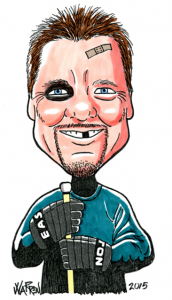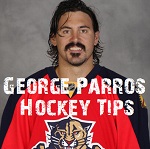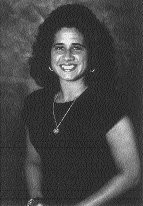Careers in the NHL: Angela Gorgone
By Bob Cunningham
Nov 6, 2000, 07:17
Step inside the offices of The Mighty Ducks of Anaheim, and you’re greeted with an atmosphere that efficiently blends the upbeat professionalism of the Walt Disney Company with a colorful extracurricular flavor that is found in pro sports.
Walk past the receptionist’s desk, turn right after strolling between two rows of decorator hockey sticks aligned like window blinds and head into the first door on the right. There, you’ll find dozens of media guides and other hockey reference materials adorning a back cabinet, organized impeccably. The quaint but ample office is cleanly decorated in The Mighty Ducks’ jade, purple and white. An impressive wood desk is neatly orchestrated, dominated by a computer terminal.
This is the office of the Coordinator of Computer Scouting and Video. This is Angela Gorgone’s office.
It’s appropriate that Gorgone’s office is the first one you reach as you head back into the arteries that make a professional organization’s heart beat. Appropriate because the role Gorgone plays intendedly works as a transfusion of information that is utilized in ultimately deciding which players are going to be donning the Ducks’ uniforms in the future.
The correspondence also aids the team in analyzing its future foes.
Arriving at this point in her career hasn’t been without the routine pitfalls and some sacrifice, but Gorgone is ecstatic over her progression into the field she’s known all along was right for her, the only one for her actually.
“I couldn’t be happier,” she beams.
Dedication, desire and hard work
Gorgone notes that the old standbys of dedication, desire and hard work are all that’s needed to begin a career in professional sports… women included.
She’s proud to say that the fact that she’s female has never really been a hindrance.
“In terms of actually someone making me feel unwelcome, or that I can’t do what I’m doing in hockey because I’m a woman, that’s never happened,” she says. “Occasionally, there’ve been times when I’ve felt more pressure. Really, I just become more determined to prove myself. To show I belong. I guess I have to know that much more than a man in the same position might have to know.”
In a sport that has spawned the integration of women into its actual product, Gorgone has pursued a more realistic approach toward a rewarding and enjoyable career in professional hockey, assisting in the operations of a National Hockey League team by virtue of her detailed knowledge of the entire organizational spectrum — from the lowest minor leagues on up.
The key for Gorgone, 26, has been her bachelors degree in sports management obtained from Ohio-based Bowling Green University. She had known since her earliest days growing up in Copiague, Long Island that she desired to pursue a career in hockey. But how to reach that goal didn’t become clear until shortly after graduation from high school.
Eat, drink and work hockey
“Growing up, we lived hockey. We ate, slept and drank the New York Rangers,” explains the single Anaheim resident. “Believe it or not, I wanted to work specifically in hockey since I was six years old.”
The sculpture of her eventual career path began to take shape after she watched Bowling Green’s 1984 hockey team outlast the University of Minnesota-Duluth in four overtimes to capture the NCAA title.
Gorgone had inquired to different colleges regarding her interests, but couldn’t locate the right type of program. Most discussed the training aspect of the game, while Gorgone was more interested in crunching numbers. She had worked as team statistician in high school in baseball, basketball and lacrosse, as well as hockey.
“I wrote to Bowling Green and they mailed me back some literature. They had a sports management degree. That was something that was relatively new at that time. I knew that’s what I wanted. They couldn’t have described it any better.”
Four years later, in the spring of 1989, Gorgone graduated with her bachelor’s. That came about five months after she began a critical internship with the New Jersey Devils.
“I wrote to different teams and received two offers — from the New Jersey Devils and the Washington Capitals,” she says. “I went with the Devils because I’m from Long Island, it was more local.”
From Bowling Green to Rangers
Gorgone credits some of her successful rise to her association with former Ranger George McPhee, a Bowling Green alumnus she came to know.
“I really admired him, not because he was a great scorer or even a great player, but because he was the hardest working player I could ever remember. I’ve never forgotten that.”
With the Devils, Gorgone functioned as Hockey Staff Assistant under Director of Player Personnel Marshall Johnston. She also worked under Max McNab, the Executive Vice President and General Manager, as well as father of David McNab, the Mighty Ducks’ present Director of Player Personnel. She compulated statistics, assisted in writing out scouting reports, assisted in the production of the media guide and also worked in community relations, helping to schedule team appearances at local charitable functions.
The Devils liked her work so much, they decided to retain her as a full-time employee following the conclusion of her internship. She remained with the Devils until July of last year.
Migrate West
It was then that, despite the incredibly positive and supportive experience of the previous four years, it was time for something else.
“I had gotten to know Jack Ferreira through a mutual friend,” Cordons explains. “When the new team was formed out here, Jack called me and I thought it was the opportunity of a lifetime. I just couldn’t refuse. My years in New Jersey were invaluable, but it was time to move on.”
Gorgone notes that she’s been given a great deal more responsibility with The Mighty Ducks than she had at New Jersey.
“I guess you could say I’m the hockey resource person. I helped develop our computer scouting system,” she said.
During Mighty Ducks games, Gorgone can be found in the press box, busily entering data into a portable computer while the game is in progress. The information she initiates is eventually digested by the powers at be, resulting in decisions that directly affect the team on the ice.
Gorgone notes that coming to sunny Southern California was really a coincidence concerning her team change. This move was based purely on her hockey career.
Enjoy what you do
“I love it out here, I really do. I had never been to Southern California before. But coming out here had nothing to do with the location,” she explains. “If this opportunity would have been in Winnipeg, I would’ve taken it. The chance to help build a new organization… it’s exciting to help build something from scratch.”
Gorgone’s future aspirations don’t differ greatly from her current situation. Actually, though, she admits she hasn’t given the long term a great deal of thought.
“I’m really concentrating right now on doing the best I can in this position. I think I’d always like to stay in the hockey department, although I don’t think I’d want to go too much into the scouting end of it because of the travel.
“It’s very important to me that you enjoy what you do. I love coming to work. I love being at the games,” she says. “It’s really not as glamorous as people think. Some people think the players come in here and hang out all day.
“But I still love it.”
Bob Cunningham is a Southern California-based freelance writer who contributes to several sports publications throughout the U.S. and Canada.
This first appeared in the 05/1994 issue of Hockey Player Magazine®
© Copyright 1991-2001 Hockey Player® and Hockey Player Magazine®





 They’re all the same… Well… Almost!
They’re all the same… Well… Almost! When you no longer have the “buzzer” to signal the end of your shift…
When you no longer have the “buzzer” to signal the end of your shift…



